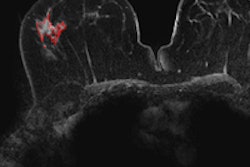To treat or not to treat ductal carcinoma in situ (DCIS). That particular question continues to be debated decades after mammography screening first began to uncover "preclinical" lesions such as DCIS, according to a March 26 presentation at the annual National Consortium of Breast Centers (NCBC) meeting in Las Vegas.
It's not an easy question to answer, said presenter Dr. Melvin Silverstein, director of Hoag Breast Care Center in Newport Beach, CA. "Some DCIS lesions need to be treated, and some do not -- but right now we can't determine between the two."
Yes, some DCIS lesions are overdiagnosed and overtreated, Silverstein said. But the benefits outweigh the harms.
"Overdiagnosing some DCIS is the price we pay for finding early invasive cancer," he told AuntMinnie.com. "We are willing to overdiagnose some things in order to catch others."
Before screening mammography, breast cancer tracking went something like this: A woman presented with a symptom, her doctor worked it up and made a diagnosis, the woman received treatment, and, ideally, the disease and its symptoms were eliminated, Silverstein said. Now, asymptomatic women are screened for disease, and in some, doctors find preclinical abnormalities, which they work up, diagnose, and treat.
The result of this shift in paradigm is that more invasive cancers are found and deaths are reduced, according to Silverstein.
| 1963 | 2013 | |
| Invasive breast cancers | 56,000 | 235,000 |
| Breast cancer deaths | 1 in 2 women | 1 in 6 women |
"In a perfect world, we would not diagnose and treat DCIS lesions that will never have any clinical significance," he said. "But that's true for any disease."
Determining treatment -- if any
Forms of treatment for DCIS include mastectomy, excision and radiation, and excision alone, Silverstein said. Mastectomy is indicated when the DCIS is large relative to breast size, when there are inadequate margins, or when a woman has a strong family history of breast cancer or is BRCA1/BRCA2 positive. But how do clinicians determine whether to treat with excision and radiation therapy versus excision alone?
Silverstein showed session attendees a chart based on the University of Southern California/Van Nuys Prognostic Index (USC/VNPI), an algorithm that quantifies five prognostic factors -- tumor size, margin width, nuclear grade, age, and comedonecrosis -- that can predict local recurrence in conservatively treated patients with DCIS.
| 2013 USC/VNPI 2013 treatment guidelines (based on less than 20% local recurrence as acceptable) | |||||
| USC/VNPI score | Treatment | 12-year recurrence | |||
| 4, 5, or 6 | Excision alone | ≤ 6% | |||
| 7, margins ≥ 3 mm | Excision alone | 16% | |||
| 7, margins < 3 mm | Radiation | 14% | |||
| 8, margins ≥ 3 mm | Radiation | 13% | |||
| 8, margins < 3 mm | Mastectomy | 0% | |||
| 9, margins ≥ 5 mm | Radiation | 26% | |||
| 9, margins < 5 mm | Mastectomy | 0% | |||
| 10, 11, or 12 | Mastectomy | 8% | |||
Silverstein also referred to the National Comprehensive Cancer Network's (NCCN) treatment guidelines, which suggest that women ages 50 or older with pure DCIS (no microinvasion), lesion size of 20 mm or less, and grade 1 or 2 can be treated with excision alone.
What's the bottom line? Some DCIS is overdiagnosed, but to what extent remains unclear, and the clinical community continues to develop protocols for determining how best to handle a diagnosis of DCIS.
"Every DCIS that is 'cured' is a potential invasive cancer prevented," he said. "But every DCIS will not progress to an invasive cancer. It seems simple: Don't treat what won't progress. But what's not so simple is determining which lesions will not progress."



















